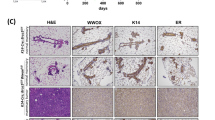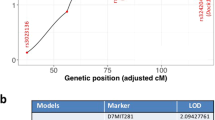Abstract
Inheritance of one defective BRCA2 allele predisposes humans to breast cancer. To establish a mouse model for BRCA2-associated breast cancer, we generated mouse conditional mutants with BRCA2 and/or p53 inactivated in various epithelial tissues, including mammary-gland epithelium. Although no tumors arose in mice carrying conditional Brca2 alleles, mammary and skin tumors developed frequently in females carrying conditional Brca2 and Trp53 alleles. The presence of one wildtype Brca2 allele resulted in a markedly delayed tumor formation; loss of the wildtype Brca2 allele occurred in a subset of these tumors. Our results show that inactivation of BRCA2 and of p53 combine to mediate mammary tumorigenesis, and indicate that disruption of the p53 pathway is pivotal in BRCA2-associated breast cancer.
This is a preview of subscription content, access via your institution
Access options
Subscribe to this journal
Receive 12 print issues and online access
$209.00 per year
only $17.42 per issue
Buy this article
- Purchase on Springer Link
- Instant access to full article PDF
Prices may be subject to local taxes which are calculated during checkout







Similar content being viewed by others
References
Ford, D. et al. Genetic heterogeneity and penetrance analysis of the BRCA1 and BRCA2 genes in breast cancer families. The Breast Cancer Linkage Consortium. Am. J. Hum. Genet. 62, 676–689 (1998).
Scully, R. & Livingston, D.M. In search of the tumour-suppressor functions of BRCA1 and BRCA2. Nature 408, 429–432 (2000).
Venkitaraman, A.R. The breast cancer susceptibility gene, BRCA2: at the crossroads between DNA replication and recombination? Phil. Trans. R. Soc. Lond. B Biol. Sci. 355, 191–198 (2000).
Yu, V.P. et al. Gross chromosomal rearrangements and genetic exchange between nonhomologous chromosomes following BRCA2 inactivation. Genes Dev. 14, 1400–1406 (2000).
Patel, K.J. et al. Involvement of Brca2 in DNA repair. Mol. Cell 1, 347–357 (1998).
Moynahan, M.E., Pierce, A.J. & Jasin, M. BRCA2 is required for homology-directed repair of chromosomal breaks. Mol. Cell 7, 263–272 (2001).
Chen, J. et al. Stable interaction between the products of the BRCA1 and BRCA2 tumor suppressor genes in mitotic and meiotic cells. Mol. Cell 2, 317–328 (1998).
Marmorstein, L.Y. et al. A human BRCA2 complex containing a structural DNA binding component influences cell cycle progression. Cell 104, 247–257 (2001).
Chen, P.L. et al. The BRC repeats in BRCA2 are critical for RAD51 binding and resistance to methyl methanesulfonate treatment. Proc. Natl Acad. Sci. USA 95, 5287–5292 (1998).
Marmorstein, L.Y., Ouchi, T. & Aaronson, S.A. The BRCA2 gene product functionally interacts with p53 and RAD51. Proc. Natl Acad. Sci. USA 95, 13869–13874 (1998).
Wong, A.K., Pero, R., Ormonde, P.A., Tavtigian, S.V., & Bartel, P.L. RAD51 interacts with the evolutionarily conserved BRC motifs in the human breast cancer susceptibility gene Brca2. J. Biol. Chem. 272, 31941–31944 (1997).
Sharan, S.K. et al. Embryonic lethality and radiation hypersensitivity mediated by Rad51 in mice lacking Brca2. Nature 386, 804–810 (1997).
Davies, A.A. et al. Role of BRCA2 in control of the RAD51 recombination and DNA repair protein. Mol. Cell 7, 273–282 (2001).
Ludwig, T., Chapman, D.L., Papaioannou, V.E. & Efstratiadis, A. Targeted mutations of breast cancer susceptibility gene homologs in mice: lethal phenotypes of Brca1, Brca2, Brca1/Brca2, Brca1/p53, and Brca2/p53 nullizygous embryos. Genes Dev. 11, 1226–1241 (1997).
Suzuki, A. et al. Brca2 is required for embryonic cellular proliferation in the mouse. Genes Dev. 11, 1242–1252 (1997).
Connor, F. et al. Tumorigenesis and a DNA repair defect in mice with a truncating Brca2 mutation. Nature Genet. 17, 423–430 (1997).
Friedman, L.S. et al. Thymic lymphomas in mice with a truncating mutation in Brca2. Cancer Res. 58, 1338–1343 (1998).
Crook, T. et al. p53 mutation with frequent novel codons but not a mutator phenotype in BRCA1- and BRCA2-associated breast tumours. Oncogene 17, 1681–1689 (1998).
Ramus, S.J. et al. Increased frequency of TP53 mutations in BRCA1 and BRCA2 ovarian tumours. Genes Chromosom. Cancer 25, 91–96 (1999).
Lee, H. et al. Mitotic checkpoint inactivation fosters transformation in cells lacking the breast cancer susceptibility gene, Brca2. Mol. Cell 4, 1–10 (1999).
Vasioukhin, V., Degenstein, L., Wise, B. & Fuchs, E. The magical touch: genome targeting in epidermal stem cells induced by tamoxifen application to mouse skin. Proc. Natl Acad. Sci. USA 96, 8551–8556 (1999).
Vassar, R., Rosenberg, M., Ross, S., Tyner, A. & Fuchs, E. Tissue-specific and differentiation-specific expression of a human K14 keratin gene in transgenic mice. Proc. Natl Acad. Sci. USA 86, 1563–1567 (1989).
Sternberg, N. & Hamilton, D. Bacteriophage P1 site-specific recombination. I. Recombination between loxP sites. J. Mol. Biol. 150, 467–486 (1981).
Sauer, B. Inducible gene targeting in mice using the Cre/lox system. Methods 14, 381–392 (1998).
Rajewsky, K. et al. Conditional gene targeting. J. Clin. Invest 98, 600–603 (1996).
Schwenk, F., Baron, U. & Rajewsky, K. A cre-transgenic mouse strain for the ubiquitous deletion of loxP-flanked gene segments including deletion in germ cells. Nucleic Acids Res. 23, 5080–5081 (1995).
Brugarolas, J. & Jacks, T. Double indemnity: p53, BRCA and cancer. p53 mutation partially rescues developmental arrest in Brca1 and Brca2 null mice, suggesting a role for familial breast cancer genes in DNA damage repair. Nature Med. 3, 721–722 (1997).
Donehower, L.A. et al. Mice deficient for p53 are developmentally normal but susceptible to spontaneous tumours. Nature 356, 215–221 (1992).
Harvey, M. et al. Spontaneous and carcinogen-induced tumorigenesis in p53-deficient mice. Nature Genet. 5, 225–229 (1993).
Harvey, M., McArthur, M.J., Montgomery, C.A., Bradley, A. & Donehower, L.A. Genetic background alters the spectrum of tumors that develop in p53-deficient mice. FASEB J. 7, 938–943 (1993).
Jacks, T. et al. Tumor spectrum analysis in p53-mutant mice. Curr. Biol. 4, 1–7 (1994).
Purdie, C.A. et al. Tumour incidence, spectrum and ploidy in mice with a large deletion in the p53 gene. Oncogene 9, 603–609 (1994).
Wagner, K.U. et al. Cre-mediated gene deletion in the mammary gland. Nucleic Acids Res. 25, 4323–4330 (1997).
Soriano, P. Generalized lacZ expression with the ROSA26 Cre reporter strain. Nature Genet. 21, 70–71 (1999).
Xu, X. et al. Conditional mutation of Brca1 in mammary epithelial cells results in blunted ductal morphogenesis and tumour formation. Nature Genet. 22, 37–43 (1999).
Kinzler, K.W. & Vogelstein, B. Cancer-susceptibility genes. Gatekeepers and caretakers. Nature 386, 761–763 (1997).
Perou, C.M. et al. Molecular portraits of human breast tumours. Nature 406, 747–752 (2000).
Cancer risks in BRCA2 mutation carriers. The Breast Cancer Linkage Consortium. J. Natl Cancer Inst. 91, 1310–1316 (1999).
Berneburg, M. & Lehmann, A.R. Xeroderma pigmentosum and related disorders: defects in DNA repair and transcription. Adv. Genet. 43, 71–102 (2001).
Bogliolo, M., Taylor, R.M., Caldecott, K.W. & Frosina, G. Reduced ligation during DNA base excision repair supported by BRCA2 mutant cells. Oncogene 19, 5781–5787 (2000).
Cavalieri, E., Frenkel, K., Liehr, J.G., Rogan, E. & Roy, D. Estrogens as endogenous genotoxic agents—DNA adducts and mutations. J. Natl Cancer Inst. Monogr. 75–93 (2000).
Liehr, J.G. Is estradiol a genotoxic mutagenic carcinogen? Endocr. Rev. 21, 40–54 (2000).
Robanus-Maandag, E. et al. p107 is a suppressor of retinoblastoma development in pRb-deficient mice. Genes Dev. 12, 1599–1609 (1998).
O'Gorman, S., Dagenais, N.A., Qian, M. & Marchuk, Y. Protamine–Cre recombinase transgenes efficiently recombine target sequences in the male germ line of mice, but not in embryonic stem cells. Proc. Natl Acad. Sci. USA 94, 14602–14607 (1997).
Munz, B. et al. Overexpression of activin A in the skin of transgenic mice reveals new activities of activin in epidermal morphogenesis, dermal fibrosis and wound repair. EMBO J. 18, 5205–5215 (1999).
Hogan, B., Beddington, R., Costantini, F. & Lacy, E. Manipulating the Mouse Embryo: a Laboratory Manual (Cold Spring Harbor Laboratory Press, Plainview, 1994).
van der Putten, H., Terwindt, E., Berns, A. & Jaenisch, R. The integration sites of endogenous and exogenous Moloney murine leukemia virus. Cell 18, 109–116 (1979).
Laird, P.W. et al. Simplified mammalian DNA isolation procedure. Nucleic Acids Res. 19, 4293 (1991).
Sambrook, J., Fritsch, E.F., & Maniatis, T. Molecular Cloning: a Laboratory Manual (Cold Spring Harbor Laboratory Press, Cold Spring Harbor, 1989).
Rasmussen, S.B., Young, L.J. & Smith, G.H. Preparing mammary gland whole mounts from mice. in Methods in Mammary Gland Biology and Cancer Research (eds. Ip, M.M. & Asch, B.B.) 75–85 (Kluwer Academic/Plenum, New York, 2000).
Acknowledgements
We thank K. Rajewsky for Cre deleter mice, P. Soriano for R26R Cre reporter–bearing mice, S. Werner for the K14 promoter construct, R. Fassler and S. O'Gorman for cre–loxP plasmids, K. van Veen-Buurman and K. van 't Wout for zygote and blastocyst injections, F. Matthesius for assistance in genotyping the mice, J. Bulthuis, K. de Goeij, D. Hoogervorst and M. Tjin-a-Koeng for histotechnical assistance, N. Bosnie, S. Greven, A. Lagro and A. Zwerver for animal care, C. Ruivenkamp for statistical analysis and A. Loonstra, H. te Riele and M. Vooijs for critically reading the manuscript. This work was supported by funding from the Dutch Cancer Society (J.J. and R.M.).
Author information
Authors and Affiliations
Corresponding author
Supplementary information
Rights and permissions
About this article
Cite this article
Jonkers, J., Meuwissen, R., van der Gulden, H. et al. Synergistic tumor suppressor activity of BRCA2 and p53 in a conditional mouse model for breast cancer. Nat Genet 29, 418–425 (2001). https://doi.org/10.1038/ng747
Received:
Accepted:
Published:
Issue Date:
DOI: https://doi.org/10.1038/ng747
This article is cited by
-
Mcam inhibits macrophage-mediated development of mammary gland through non-canonical Wnt signaling
Nature Communications (2024)
-
KRAS allelic imbalance drives tumour initiation yet suppresses metastasis in colorectal cancer in vivo
Nature Communications (2024)
-
Identification of aberrant luminal progenitors and mTORC1 as a potential breast cancer prevention target in BRCA2 mutation carriers
Nature Cell Biology (2024)
-
An entosis-like process induces mitotic disruption in Pals1 microcephaly pathogenesis
Nature Communications (2023)
-
UHRF1 is a mediator of KRAS driven oncogenesis in lung adenocarcinoma
Nature Communications (2023)



